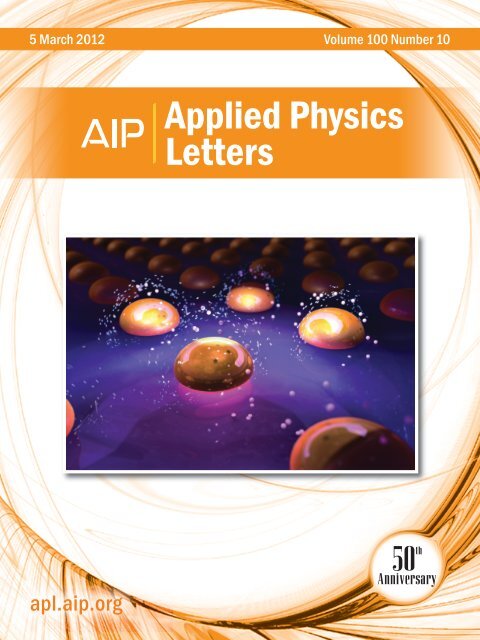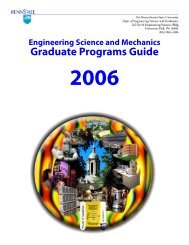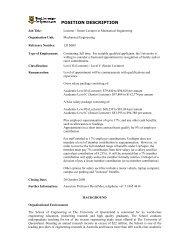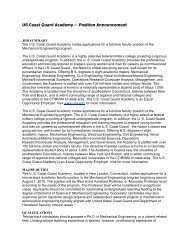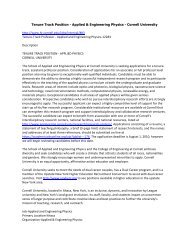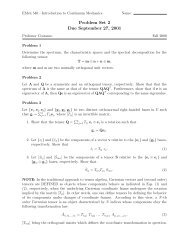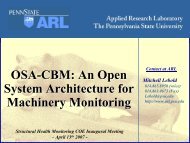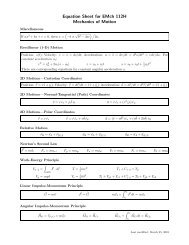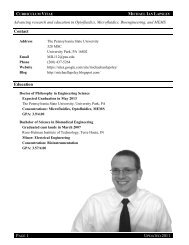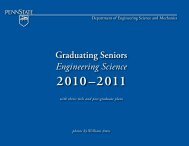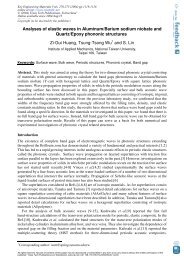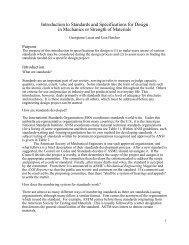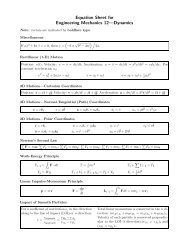Applied Physics Letters - Engineering Science and Mechanics
Applied Physics Letters - Engineering Science and Mechanics
Applied Physics Letters - Engineering Science and Mechanics
You also want an ePaper? Increase the reach of your titles
YUMPU automatically turns print PDFs into web optimized ePapers that Google loves.
5 March 2012 Volume 100 Number 10<br />
apl.aip.org<br />
<strong>Applied</strong> <strong>Physics</strong><br />
<strong>Letters</strong><br />
50 th<br />
Anniversary
Shifts in plasmon resonance due to charging of a nanodisk array in argon<br />
plasma<br />
Michael Ian Lapsley, Anaram Shahravan, Qingzhen Hao, Bala Krishna Juluri, Stephen Giardinelli et al.<br />
Citation: Appl. Phys. Lett. 100, 101903 (2012); doi: 10.1063/1.3673327<br />
View online: http://dx.doi.org/10.1063/1.3673327<br />
View Table of Contents: http://apl.aip.org/resource/1/APPLAB/v100/i10<br />
Published by the American Institute of <strong>Physics</strong>.<br />
Related Articles<br />
Quasi first-principles Monte Carlo modeling of energy dissipation by low-energy electron beams in multi-walled<br />
carbon nanotube materials<br />
Appl. Phys. Lett. 100, 093113 (2012)<br />
Influence of a depletion layer on localized surface waves in doped semiconductor nanostructures<br />
Appl. Phys. Lett. 100, 091103 (2012)<br />
A pancake-shaped nano-aggregate for focusing surface plasmons<br />
J. Appl. Phys. 111, 034308 (2012)<br />
Plasmon assisted light propagation <strong>and</strong> Raman scattering hot-spot in end-to-end coupled silver nanowire pairs<br />
Appl. Phys. Lett. 100, 043108 (2012)<br />
Energy-filtered phase retrieval using the transport of intensity equation<br />
Appl. Phys. Lett. 99, 221905 (2011)<br />
Additional information on Appl. Phys. Lett.<br />
Journal Homepage: http://apl.aip.org/<br />
Journal Information: http://apl.aip.org/about/about_the_journal<br />
Top downloads: http://apl.aip.org/features/most_downloaded<br />
Information for Authors: http://apl.aip.org/authors
Shifts in plasmon resonance due to charging of a nanodisk array in argon<br />
plasma<br />
Michael Ian Lapsley, 1 Anaram Shahravan, 2 Qingzhen Hao, 1,3 Bala Krishna Juluri, 1<br />
Stephen Giardinelli, 1 Mengqian Lu, 1 Yanhui Zhao, 1 I-Kao Chiang, 1 Themis Matsoukas, 2<br />
<strong>and</strong> Tony Jun Huang 1,a)<br />
1 Department of <strong>Engineering</strong> <strong>Science</strong> <strong>and</strong> <strong>Mechanics</strong>, The Pennsylvania State University, University Park,<br />
Pennsylvania 16802, USA<br />
2 Department of Chemical <strong>Engineering</strong>, The Pennsylvania State University, University Park,<br />
Pennsylvania 16802, USA<br />
3 Department of <strong>Physics</strong>, The Pennsylvania State University, University Park, Pennsylvania 16802, USA<br />
(Received 15 November 2011; accepted 6 December 2011; published online 5 March 2012)<br />
A method for generating charge-induced plasmonic shifts, using argon plasma to charge<br />
nanoparticle arrays, is presented. Particles develop a negative charge, due to enhanced collisions<br />
with high-temperature electrons, in low-temperature plasmas. The negative charge generated<br />
causes a blue shift in the localized surface plasmon resonance. The dynamics of the shift were<br />
recorded <strong>and</strong> discussed. This effect could be used as a real-time method for studying the dynamics<br />
for charging in plasma. VC 2012 American Institute of <strong>Physics</strong>. [doi:10.1063/1.3673327]<br />
Plasmonics deals with optically excited, oscillations of<br />
electrons at the interface between a metal <strong>and</strong> a dielectric, 1<br />
<strong>and</strong> this phenomenon has driven the development of many<br />
optical devices. 2–9 Surface plasmons excited in metal structures,<br />
confined at the nanoscale in three dimensions (i.e.,<br />
nanoparticles, nanodisks, etc.), are known as localized surface<br />
plasmons. At certain wavelengths, maximum coupling<br />
from electromagnetic waves to localized surface plasmons<br />
can be achieved <strong>and</strong> these are known as the localized surface<br />
plasmon resonances (LSPRs) of the structure. LSPRs of<br />
metal nanostructures depend on properties such as the<br />
size, 10,11 shape, 12–14 metal material, 15 surrounding dielectric<br />
material, 16–22 <strong>and</strong> the charge of the metal. 23–30 Active plasmonic<br />
devices can be realized by externally tuning the LSPR<br />
of nanostructures. Previously, chemical/electrochemical<br />
charging was used to actively tune the LSPR of arrays of<br />
both silver 24,25,30 <strong>and</strong> gold 23,26,27,29 nanostructures; however,<br />
this process is relatively slow. In this study, a rapid shift in<br />
the LSPR of an array of gold nanodisks was induced by surrounding<br />
the particles with a low-temperature argon plasma.<br />
This shift can be explained by the charging effect of the<br />
plasma. 31–34 Charging by the plasma takes place in only seconds,<br />
where chemical/electrochemical charging can take several<br />
minutes 24 to hours. 27 This method allows real-time<br />
monitoring of the charging effect induced by low-pressure<br />
plasmas <strong>and</strong> could be utilized for photonics applications<br />
based on the LSPR shift.<br />
In the experiment, the optical extinction spectrum of an<br />
array of gold nanodisks was measured while generating<br />
plasma. An array of gold nanodisks (diameters of 120 nm,<br />
thicknesses of 30 nm, <strong>and</strong> a periodicity of 300 nm) was fabricated<br />
on glass via electron-beam lithography. 35 A custom<br />
vacuum chamber was designed to include two flat, parallel<br />
windows to allow transmission of a probe light (Fig. 1(a)).<br />
The nanodisk array was placed inside the vacuum chamber<br />
a)<br />
Author to whom correspondence should be addressed. Electronic mail:<br />
junhuang@psu.edu.<br />
APPLIED PHYSICS LETTERS 100, 101903 (2012)<br />
where it was attached to one of the flat windows. The probe<br />
light, ejected from the input optical fiber <strong>and</strong> collimated by a<br />
lens, traveled through the vacuum chamber <strong>and</strong> the sample.<br />
The output light was collected by the output lens/optical fiber<br />
<strong>and</strong> delivered to an optical spectrometer. A vacuum system<br />
was used to evacuate the chamber to a base pressure of 150<br />
mTorr. Argon was introduced into the chamber using a mass<br />
flow controller. The argon gas was introduced at a flow rate<br />
of 6 SCCM <strong>and</strong> was ionized via an RF-driven, capacitively<br />
coupled, low-pressure discharge (30 W, 13.56 MHz) across<br />
two ring-shaped, aluminum electrodes.<br />
FIG. 1. (Color online) Experimental setup <strong>and</strong> device used in the experiment.<br />
(a) Schematic of the vacuum chamber, sample position, <strong>and</strong> optical<br />
setup. (b) Working mechanism for charging by plasma. (c) SEM image of<br />
the gold nanoparticles.<br />
0003-6951/2012/100(10)/101903/3/$30.00 100, 101903-1<br />
VC 2012 American Institute of <strong>Physics</strong>
101903-2 Lapsley et al. Appl. Phys. Lett. 100, 101903 (2012)<br />
FIG. 2. (Color online) (a) Experimental extinction spectrum for gold nanodisk<br />
array. Raw data is shown as solid lines. The fitted curve for the initial<br />
position (dashed line) <strong>and</strong> the final position (dashed-dotted line) are shown<br />
as dashed lines. The insert displays a closer view of the peak positions. (b)<br />
The extinction spectrums for the initial position (solid line) <strong>and</strong> the final<br />
position (dashed line) of the extinction spectrum simulated using DDA for<br />
the experimental conditions.<br />
Argon plasma consists of a mixture of argon ions <strong>and</strong><br />
free electrons, both of which are characterized by their own<br />
temperature. Electrons have a low mass <strong>and</strong> are quickly<br />
accelerated in the high-frequency electric field; the ions,<br />
whose mass is significantly higher, are not affected by the<br />
quickly alternating field. Consequently, the electrons acquire<br />
a high temperature while the ions are essentially at room<br />
temperature. The ions <strong>and</strong> the electrons collide with the gold<br />
nanodisks as shown schematically in Fig. 1(b). An electron<br />
collision injects a negative charge onto the particle, whereas<br />
an ion collision removes an electron. Since the electron temperature<br />
is higher than that of the ions, electron collisions<br />
happen more frequently, causing the particles to develop a<br />
negative net charge. Eventually, equilibrium is reached<br />
between the high probability of electron collisions <strong>and</strong> the<br />
repulsion of electrons due to the negative charge developed<br />
on the nanodisk.<br />
FIG. 3. (Color online) Dynamic response of the LSPR peak shift for three<br />
separate tests with a single nanodisk sample. The peak position of the fitted<br />
curve was recorded every 0.1 s. The blue circle <strong>and</strong> red square indicate the<br />
data points corresponding to the peak position of the initial <strong>and</strong> final curves<br />
plotted in Fig. 2(a), respectively.<br />
Figure 2(a) displays the extinction spectrum for the sample<br />
before <strong>and</strong> after the plasma was ignited in the chamber.<br />
A curve was fitted to the raw data to determine the peak position.<br />
The fitted curve for each spectrum is shown as a dotted<br />
line over the raw data in Fig. 2(a), <strong>and</strong> its peak position was<br />
used to characterize shifts in the resonance spectrum. The<br />
initial peak position (ki) was 661.1 nm. When the plasma<br />
was generated, the peak position blue-shifted <strong>and</strong> settled at<br />
655.7 nm (k f).<br />
In order to study the dynamics <strong>and</strong> variability in the peak<br />
position during charging, a spectrum was recorded every 0.1 s<br />
during the experiment. A curve was fitted to each spectrum,<br />
<strong>and</strong> its peak position was plotted vs. time (Fig. 3, test 3). Data<br />
were collected for 10 s before igniting the plasma to record<br />
the initial variation, <strong>and</strong> the mean (l) was 661.0835 nm with a<br />
st<strong>and</strong>ard deviation (r) of 0.0734 nm. Immediately after igniting<br />
the plasma, the peak position blue-shifted. The initial shift<br />
happens in about 2 s with some overshoot lasting 10 s. With<br />
some optimization, the speed of this shift ( 2 s) could be a<br />
major advantage of this technique as compared with electrochemical<br />
charging (>3min). 24 After stabilization, the final<br />
position was analyzed (l ¼ 655.711 nm, r ¼ 0.1295 nm). The<br />
plasma was active for another 1 min, while spectra were collected<br />
every 5 s (l ¼ 655.735 nm, r ¼ 0.0754 nm). Subsequently,<br />
the plasma was removed, but no immediate red-shift<br />
was observed in the data. The peak position was monitored<br />
for about 5 more minutes yielding l ¼ 655.855 nm <strong>and</strong><br />
r ¼ 0.1513 nm. The slight increase in the l <strong>and</strong> r was due to<br />
mechanical vibrations altering the homogeneous broadening<br />
of the extinction spectrum. The plasma was reignited while<br />
spectra were again recorded every 0.1 s, but no blue-shift was<br />
observed. This entire data set was analyzed yielding<br />
l ¼ 656.453 nm <strong>and</strong> r ¼ 0.1325 nm. The low st<strong>and</strong>ard deviation<br />
indicated that no significant change occurred throughout<br />
the second ignition of the plasma.
101903-3 Lapsley et al. Appl. Phys. Lett. 100, 101903 (2012)<br />
The plasma was extinguished, <strong>and</strong> the chamber was<br />
returned to atmospheric pressure. The sample was left in the<br />
test chamber at atmospheric pressure for 1 week, after which<br />
the LSPR red-shifted back to its initial position. The test was<br />
repeated three times with the same sample, <strong>and</strong> a similar pattern<br />
in the data was observed. In all three cases, the overall<br />
blue-shift was about 5 nm, <strong>and</strong> the discharge process lasted<br />
about 1 week. Essentially, the disks were charged by the initial<br />
exposure to the plasma <strong>and</strong> remained charged, as there<br />
was no path to electrical ground to allow discharging. Eventually,<br />
the electrons will discharge through the glass wall of<br />
the chamber, returning the particles to a neutral state. Tests<br />
1, 2, <strong>and</strong> 3 all match closely (ki 660 nm <strong>and</strong> kf 655), with<br />
some differences in overshoot. The differences in each dataset<br />
are very interesting <strong>and</strong> need more exploration to fully<br />
verify the physical mechanism; however, a faster method for<br />
discharging the particles must be introduced.<br />
Other phenomena, besides charging, have been shown<br />
to induce blue shifts in the LSPR spectrum which must be<br />
excluded as possible causes for the shift observed in this<br />
study. Reducing the size of particles via etching can cause a<br />
blue shift in the spectrum. 11 Etching is not a reversible process.<br />
In this study, the peak position eventually returned to<br />
its original state, indicating that etching did not occur. The<br />
deposition of dielectric material on the surface of the nanodisk<br />
array will cause a red shift <strong>and</strong> its removal would cause<br />
a blue shift. 17–19 In this study, any material loosely adsorbed<br />
to the surface of the sample would be removed during the<br />
evacuation of the vacuum chamber, prior to data collection.<br />
Thus, the blue shift was not a result of etching or material<br />
removal.<br />
The change in electron density, which is required to<br />
cause the LSPR shift observed in this study, was predicted<br />
by the following equation: 30<br />
Nf ¼ k2i<br />
k 2<br />
f<br />
Ni; (1)<br />
where N i, 5.9 10 28 electrons/m 3 , is the initial/uncharged<br />
free electron density for gold, <strong>and</strong> ki (661.1 nm) <strong>and</strong> kf<br />
(655.7 nm) are the initial <strong>and</strong> final peak positions of the<br />
extinction spectrum, respectively. The value of N f for these<br />
conditions is 5.9976 10 28 electrons/m 3 , yielding a percent<br />
change in charge density of 1.654%. Assuming the change in<br />
charge density calculated by Eq. (1), the disk geometry was<br />
simulated using the discrete dipole approximation (DDA) to<br />
predict the extinction spectrum. 26 Dielectric data for gold<br />
was predicted as in our previous work 26 <strong>and</strong> the surrounding<br />
dielectric was approximated as the root mean square of that<br />
of vacuum <strong>and</strong> glass. The results of this simulation are<br />
shown in Fig. 2(b), where the solid curve is the initial spectrum<br />
<strong>and</strong> the dotted curve is the final spectrum. The simulated<br />
curves were sharper <strong>and</strong> have peak positions at a<br />
slightly shorter wavelength. The peak shift in the simulations<br />
was 5 nm corresponding with the shift of 5.4 nm observed in<br />
the experiments. Despite the good results of this analysis,<br />
Eq. (1) is only valid for spherical particles with a radius<br />
much smaller than the wavelength; whereas, the particles<br />
used in this experiment are relatively large <strong>and</strong> disk-shaped.<br />
Also, others have observed that the increase in electron den-<br />
sity calculated by Eq. (1) can be greatly exaggerated, 28 but<br />
the reason for this increase is currently unknown.<br />
In conclusion, a method for shifting the LSPR of gold<br />
nanodisks was demonstrated. The nanodisks were charged<br />
by electron collisions in argon plasma. The nanodisks<br />
quickly charge in the plasma <strong>and</strong> remain charged for up to<br />
one week. Monitoring the LSPR allows a real-time method<br />
for analyzing the charging effect induced by plasma. The<br />
process was repeatable <strong>and</strong> its dynamics were faster than<br />
other charge-based shifting methods. Optimization of the<br />
charging <strong>and</strong> discharging of the nanodisks could allow the<br />
rapid switching response to be utilized as an optical device.<br />
1 S. Maier, Plasmonics: Fundamentals <strong>and</strong> Applications (Springer, Berlin,<br />
2007).<br />
2 L. Feng, A. Mizrahi, S. Zamek, Z. Liu, V. Lomakin, <strong>and</strong> Y. Fainman, ACS<br />
Nano 5, 5100 (2011).<br />
3 D. E. Gomez, K. C. Vernon, P. Mulvaney, <strong>and</strong> T. J. Davis, Appl. Phys.<br />
Lett. 96, 073108 (2010).<br />
4 D. E. Gomez, K. C. Vernon, P. Mulvaney, <strong>and</strong> T. J. Davis, Nano Lett. 10,<br />
274 (2010).<br />
5 D. Lu, J. Kan, E. E. Fullerton, <strong>and</strong> Z. Liu, Appl. Phys. Lett. 98, 243114<br />
(2011).<br />
6 C. Ma <strong>and</strong> Z. Liu, J. Nanophotonics 5, 051604 (2011).<br />
7 W. Srituravanich, L. Pan, Y. Wang, C. Sun, D. B. Bogy, <strong>and</strong> X. Zhang,<br />
Nat. Nanotechnol. 3, 733 (2008).<br />
8 Y. Wang, W. Srituravanich, C. Sun, <strong>and</strong> X. Zhang, Nano Lett. 8, 3041 (2008).<br />
9 Y. Zhao, S.-C. S. Lin, A. A. Nawaz, B. Kiraly, Q. Hao, Y. Liu, <strong>and</strong> T. J.<br />
Huang, Opt. Express 18, 23458 (2010).<br />
10 M. K. Kinnan <strong>and</strong> G. Chumanov, J. Phys. Chem. C 114, 7496 (2010).<br />
11 Y. B. Zheng, L. Jensen, W. Yan, T. R. Walker, B. K. Juluri, L. Jensen, <strong>and</strong><br />
T. J. Huang, J. Phys. Chem. C 113, 7019 (2009).<br />
12 C. L. Nehl <strong>and</strong> J. H. Hafner, J. Mater. Chem. 18, 2415 (2008).<br />
13 C. Orendorff, T. Sau, <strong>and</strong> C. Murphy, Small 2, 636 (2006).<br />
14 K. C. Vernon, A. M. Funston, C. Novo, D. E. Gomez, P. Mulvaney, <strong>and</strong> T.<br />
J. Davis, Nano Lett. 10, 2080 (2010).<br />
15 J.-H. Kim, W. W. Bryan, <strong>and</strong> T. R. Lee, Langmuir 24, 11147 (2008).<br />
16 Q. Hao, Y. Zhao, B. K. Juluri, B. Kiraly, J. Liou, I. C. Khoo, <strong>and</strong> T. J.<br />
Huang, J. Appl. Phys. 109, 084340 (2011).<br />
17 J. Heckel, F. Farhan, <strong>and</strong> G. Chumanov, Colloid Polym. Sci. 286, 1545<br />
(2008).<br />
18 M. K. Kinnan, S. Kachan, C. K. Simmons, <strong>and</strong> G. Chumanov, J. Phys.<br />
Chem. C 113, 7079 (2009).<br />
19 E. M. Larsson, J. Alegret, M. Käll, <strong>and</strong> D. S. Sutherl<strong>and</strong>, Nano Lett. 7,<br />
1256 (2007).<br />
20 Y. J. Liu, Q. Hao, J. S. T. Smalley, J. Liou, I. C. Khoo, <strong>and</strong> T. J. Huang,<br />
Appl. Phys. Lett. 97, 091101 (2010).<br />
21 C. Sun, K.-H. Su, J. Valentine, Y. T. Rosa-Bauza, J. A. Ellman, O.<br />
Elboudwarej, B. Mukherjee, C. S. Craik, M. A. Shuman, F. F. Chen et al.,<br />
ACS Nano 4, 978 (2010).<br />
22 Y. B. Zheng, Y.-W. Yang, L. Jensen, L. Fang, B. K. Juluri, A. H. Flood, P.<br />
S. Weiss, J. F. Stoddart, <strong>and</strong> T. J. Huang, Nano Lett. 9, 819 (2009).<br />
23 T. Baum, D. Bethell, M. Brust, <strong>and</strong> D. J. Schiffrin, Langmuir 15, 866<br />
(1999).<br />
24 R. Chapman <strong>and</strong> P. Mulvaney, Chem. Phys. Lett. 349, 358 (2001).<br />
25 J. K. Daniels <strong>and</strong> G. Chumanov, J. Electroanal. Chem. 575, 203 (2005).<br />
26 B. K. Juluri, Y. B. Zheng, D. Ahmed, L. Jensen, <strong>and</strong> T. J. Huang, J. Phys.<br />
Chem. C 112, 7309 (2008).<br />
27 P. Mulvaney, J. Pérez-Juste, M. Giersig, L. Liz-Marzán, <strong>and</strong> C. Pecharro-<br />
mán, Plasmonics 1, 61 (2006).<br />
28 A. C. Templeton, J. J. Pietron, R. W. Murray, <strong>and</strong> P. Mulvaney, J. Phys.<br />
Chem. A 104, 564 (2000).<br />
29 A. Toyota, N. Nakashima, <strong>and</strong> T. Sagara, J. Electroanal. Chem. 565, 335<br />
(2004).<br />
30 T. Ung, M. Giersig, D. Dunstan, <strong>and</strong> P. Mulvaney, Langmuir 13, 1773<br />
(1997).<br />
31 T. Matsoukas, J. Aerosol Sci. 25, 599 (1994).<br />
32 T. Matsoukas <strong>and</strong> M. Russell, J. Appl. Phys. 77, 4285 (1995).<br />
33 T. Matsoukas <strong>and</strong> M. Russell, Phys. Rev. E 55, 991 (1997).<br />
34 A. Shahravan, C. Lucas, <strong>and</strong> T. Matsoukas, J. Appl. Phys. 108, 083303 (2010).<br />
35 Q. Hao, Y. Zeng, X. Wang, Y. Zhao, B. Wang, I.-K. Chiang, D. H.<br />
Werner, V. Crespi, <strong>and</strong> T. J. Huang, Appl. Phys. Lett. 97, 193101 (2010).


